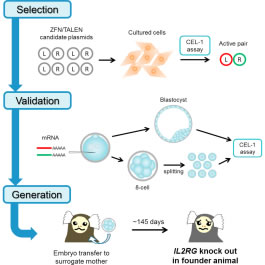Research Highlights
Vol.8, December 2016
First non-human primate model for severe combined immunodeficiency
While many insights are gained into diseases and genetic disorders from rodent models, there is a pressing need to find models that can more accurately represent disease progression in the human body, such as non-human primates. The latest advances in genome editing technology are opening doors to generating non-human primate models for studying specific genetic disorders, such as X-linked severe combined immunodeficiency (X-SCID).
X-SCID patients do not produce enough T-cells and natural killer cells to tackle infections. The condition stems from a defective gene, IL2-RG, and scientists are keen to know more about the disorder and how to improve treatment. Now, Erika Sasaki at the Central Institute for Experimental Animals, Kawasaki, and co-workers across Japan and the US, have successfully generated the first ever non-human primate X-SCID models by using two genome editing techniques – zinc-finger nucleases (ZFNs) and transcription activator-like effector nucleases (TALENs).
The team worked with marmoset monkeys because they are easy to handle and have a small body size perfect for testing small amount of new drugs in preclinical trials. They screened the most effective ZFNs to knock-out IL2-RG gene among the 16 pairs of candidate ZFNs cultured cells. They then injected the selected ZFNs into 1 cell stage marmoset embryos and performed a specialized screening test to check for, and avoid, mosaicism (if the models carrying the mutant gene in the all of the tissues in the body or not).
The researchers then transferred the embryos to surrogate mothers. Of the 5 ZFN and 4 TALEN baby marmosets that were born, three have since survived to adulthood and represent the first group of X-SCID non-human primate models ever created.
Further tests showed that the IL2-RG knockout marmoset models exhibited strong phenotypic similarities to human patients with X-SCID. Sasaki’s team are confident that their work paves the way for the creation of multiple gene knock-out models for specific diseases and genetic disorders.
Reference and affiliations
K. Sato1, R. Oiwa1, W. Kumita1, R. Henry2, T. Sakuma3, R. Ito1, R. Nozu1 , T. Inoue1, I. Katano1, K. Sato4, N. Okahara1, J. Okahara1, Y. Shimizu1 , M. Yamamoto1 , K. Hanazawa5, T. Kawakami6, Y. Kametani7, R. Suzuki8, T. Takahashi1, E. J. Weinstein2, T. Yamamoto3, Y. Sakakibara4, S. Habu9, J. Hata1, H. Okano10*, & E. Sasaki1,11,* Generation of a nonhuman primate model of severe combined immunodeficiency using highly efficient genome editing. Cell Stem Cell 19 127-138 (2016)
- 1. Central Institute for Experimental Animals, Kawasaki, Kanagawa 210-0821, Japan
- 2. Horizon Discovery, Saint Louis, MO 63146, USA
- 3. Department of Mathematical and Life Sciences, Graduate School of Science, Hiroshima University, Hiroshima 739-8526, Japan
- 4. Department of Biosciences and Informatics, Keio University, Yokohama, Kanagawa 223-8522, Japan
- 5. Department of Oncology, Juntendo University Nerima Hospital, Nerima-ku, Tokyo 177-8521, Japan
- 6. Medical Proteo Scope Company, Ltd., Yokohama, Kanagawa 236-0004, Japan
- 7. Department of Molecular Life Science, Division of Basic Medical Science and Molecular Medicine, Tokai University School of Medicine, Isehara, Kanagawa 259-1193, Japan
- 8. Department of Rheumatology and Clinical Immunology, Clinical Research Center for Rheumatology and Allergy, Sagamihara National Hospital, Sagamihara, Kanagawa 252-0392, Japan
- 9. Atopy Research Center, Juntendo University Graduate School of Medicine, Bunkyo-ku, Tokyo 113-8421, Japan
- 10. Department of Physiology, Keio University School of Medicine, Shinjuku-ku, Tokyo 160-8582, Japan
- 11. Advanced Research Center, Keio University, Shinjuku-ku, Tokyo 160-8582, Japan
- *Correspondence: hidokano@a2.keio.jp (H.O.), esasaki@ciea.or.jp (E.S.)
- DOI: http://dx.doi.org/10.1016/j.stem.2016.06.003
Figure:







